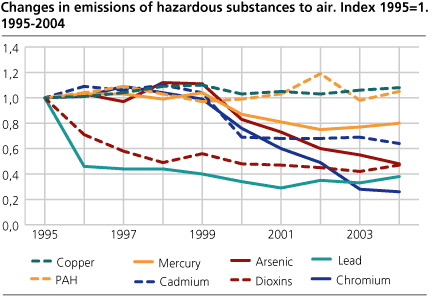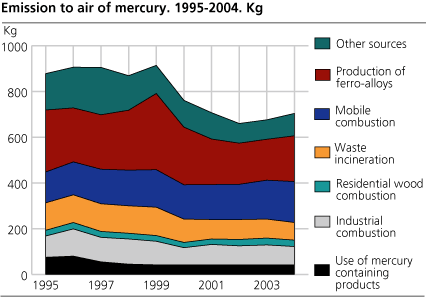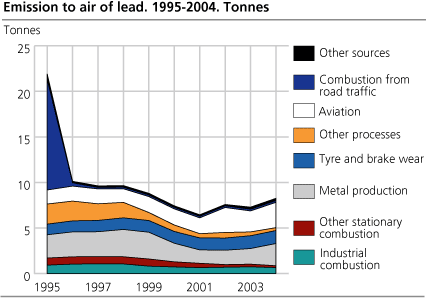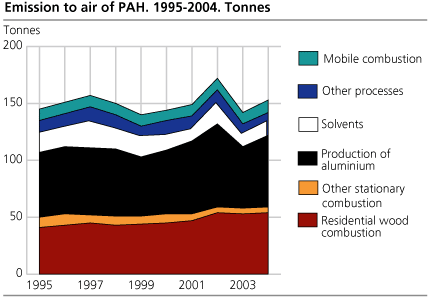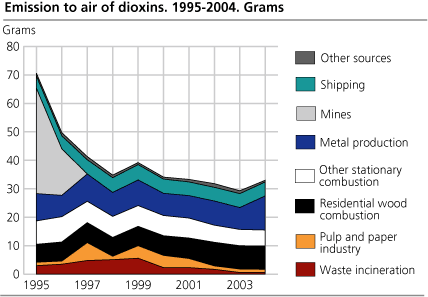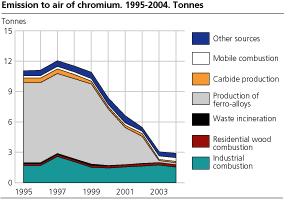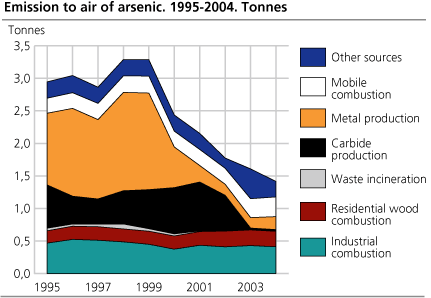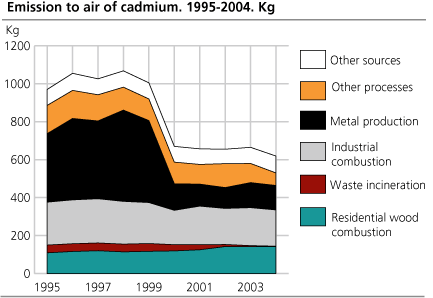Content
Published:
This is an archived release.
Small changes in heavy metals emissions
Norwegian emissions to air of many heavy metals have been substantially reduced since 1995, in accordance with national targets and international obligations. Many reductions took place some years ago, whereas there have been small changes during the last couple of years.
The figures presented here have been calculated by Statistics Norway (SSB) in collaboration with the Norwegian Pollution Control Authority (SFT).
The decline since 1995 is mainly due to reduced emissions in the manufacturing industries, which is caused by improved treatment systems and manufacturing processes and also lower activity in some industries. In addition, emissions of lead from road traffic have been dramatically reduced in the period 1990 to 1997, because of phasing out of use of leaded petrol. Since 1995, emissions from firewood and road traffic have increased for all heavy metals and POPs, except for lead and dioxins emissions from road traffic. No efficient measures have been introduced to reduce heavy metals emissions from these sources.
Policy objectives for reducing emissions
Through the Convention on Long-Range Transboundary Air Pollution, Norway is internationally committed to reduce emissions of PAH, dioxins, lead, cadmium and mercury below 1990 emission levels.
At the national level, the authorities have set targets for reducing the total emissions of selected environmental hazardous substances by 2010, using 1995 as a reference year. The figures presented in this article only refer to emissions to air.
Emissions in 2004
704 kilos of mercury were emitted to air in 2004, which is 4 per cent more than in the preceding year. The increase was mainly due to higher emissions from metal production, caused both by larger production and the fact that the treatment system at one plant was partly out of order. Increased use of diesel cars led to 10 per cent higher emissions from road traffic. Compared to 1995, however, total mercury emissions have been reduced by 20 per cent.
8.3 tonnes of lead were emitted during 2004, which is 13 per cent more than in 2003. The increase was mainly due to higher emissions from metal production, caused both by larger production and the fact that the treatment system at one plant was partly out of order. Leaded petrol is still used in small aircrafts, and approximately one third of the total emissions stemmed from this source. Less use of leaded petrol is the main cause for the emission reduction from 22 tonnes in 1995 to 8 tonnes in 2004. Emissions from road traffic were reduced by more than 98 per cent during this period.
153 tonnes of Polycyclic Aromatic Hydrocarbons (PAH) were released to the atmosphere during 2004, mainly from manufacturing of aluminium and domestic use of firewood. The emissions were 7 per cent higher than in 2003, because of higher emissions from aluminium production. Compared with 1995, the emissions in 2004 were 5 per cent higher, mainly because of increased emissions from firewood - these rose by more than 30 per cent during the period.
Emissions of dioxins totalled about 33 grams in 2004; this is 12 per cent more than in 2003. The increase was caused by larger metal production - more than one third of the emissions in 2004 stemmed from this source. Since 1995, the emissions have been reduced by more than 50 per cent.
2.9 tonnes chromium were emitted in 2004, which is 5 per cent less than in 2003. Almost one third of the emissions stemmed from combustion in pulp and paper manufacturing plants. Since 1995, the emissions have been reduced by 74 per cent; emissions from ferroalloy production alone have been reduced by 98 per cent in the same period.
Emissions of copper came to nearly 20 tonnes in 2004, which is roughly the same as in 2003. Almost half of the copper emitted to air came from tyre and brake wear, and a fourth came from combustion of petrol and diesel. The emissions were 8 per cent higher in 2004, compared with 1995.
1.4 tonnes of arsenic were emitted in 2004, which is 12 per cent less than in the preceding year. The reduction is due to lower arsenic content in coke used in metal production. The arsenic emissions have been halved since 1995.
Emissions of cadmium to air in 2004 were a little more than 600 kilos, which is at the same level as in the preceding years. Since 1995, however, the emissions have been reduced by more than a third, mainly due to reduced emissions from metal production.
Uncertainties
The emission data are calculated by Statistics Norway in cooperation with the Norwegian Pollution Control Authority. They are based on measurements from large industrial plants and combustion plants, combined with calculations based on activity data and emission factors. There is large uncertainty associated with the statistics for heavy metals and persistent organic pollutants, mainly due to variations in reported emission data. These sometimes vary largely between years, although the actual emissions may be at the same level; thus, an evaluation of whether it is reasonable to use the reported figures or not, is necessary.
Recalculations
The emission figures for all years from 1990 are annually recalculated, as new information is obtained, in order to have figures for the whole time series that are as consistent as possible. Accordingly, the figures presented here differ somewhat from those presented earlier. A revised emission factor for mercury from combustion of firewood and wood waste causes higher emissions. In the present figures, emissions from Russian activity at Svalbard are included for the first time, which also causes somewhat higher emissions.
Documentation of the Norwegian emission inventory
Statistics Norway has recently published a documentation of the methodologies for estimating emissions in the Norwegian emission inventory. The report, which describes methods, use of activity data, data sources and emission factors is used as a basis in Norway's annual emission reports to the United Nation Framework Convention on Climate Change (UNFCCC) and United Nations Economic Commission for Europe (UNECE). The report can be downloaded .
Other articles published today
Norway far from nitrogen target (9.2.2006)
New calculations gave lower emissions (9.2.2006)
More figures in StatBank .
Tables:
The statistics is published with Emissions to air.
Contact
-
Statistics Norway's Information Centre
E-mail: informasjon@ssb.no
tel.: (+47) 21 09 46 42

